-
-
Kostenlose Software für Studierende
Ansys unterstützt die nächste Generation von Ingenieur*innen
Studenten erhalten kostenlosen Zugang zu erstklassiger Simulationssoftware.
-
Verbinden Sie sich jetzt mit Ansys!
Gestalten Sie Ihre Zukunft
Stellen Sie eine Verbindung mit Ansys her, um zu erfahren, wie Simulation Ihren nächsten Durchbruch vorantreiben kann.
Länder und Regionen
Kostenlose Demoversionen
Produkte & Dienstleistungen
Lernportal
Über das Unternehmen
Back
Produkte & Dienstleistungen
Back
Lernportal
Ansys unterstützt die nächste Generation von Ingenieur*innen
Studenten erhalten kostenlosen Zugang zu erstklassiger Simulationssoftware.
Back
Über das Unternehmen
Gestalten Sie Ihre Zukunft
Stellen Sie eine Verbindung mit Ansys her, um zu erfahren, wie Simulation Ihren nächsten Durchbruch vorantreiben kann.
Kostenlose Demoversionen
ANSYS BLOG
May 27, 2022
5 Best Practices for Hydrogen Gas Turbine Combustor Meshing
The International Air Transport Association (IATA) set a target to reduce CO2 emissions by 50% in 2050 (compared to 2005 emission levels), with no increase in net emissions after 2020. They also expect the global aviation demand to double to 8.2 billion passengers per year by 2037. These issues have prompted the aviation industry to focus on transitioning from natural gas to sustainable aviation fuels (SAF), hydrogen, and hydrogen blends.
Hydrogen as an alternative to fossil fuels yields a remarkably high energy density per unit mass, superior ignition characteristics, and a wide flammability limit. However, it presents many challenges, including:
- Production and storage
- Flame stability
- Flashback
Last year, we published our 5 Best Practices for Gas Turbine Combustion Meshing Using Ansys Fluent, but hydrogen-fueled combustors pose their own unique challenges and require different best practices.
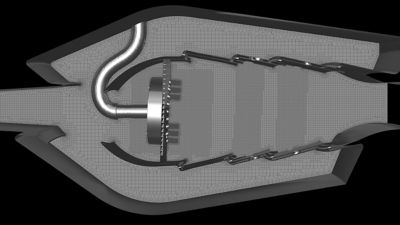
Hydrogen-fueled combustor with a micromixer
Combustors are complex geometries with detailed features that can result in long turnaround times for the meshing process. Ansys Fluent accelerates the meshing of large, complex geometries like those of combustors. Following our five best practices will enable users to generate a high-quality mesh that will yield robust, accurate results.
The five best practices for hydrogen gas turbine combustor meshing using Fluent are:
- Watertight geometry workflow
- Mosaic poly-hexcore meshing with parallel scalability
- Inflation layers
- Mesh resolution per part
- Target quality metrics
To learn about these best practices in detail, read the Ansys white paper 5 Best Practices for Hydrogen Gas Turbine Combustor Meshing Using Ansys Fluent. For an overview of these best practices, continue reading below.
1. Watertight Geometry Workflow
The watertight geometry workflow in Fluent accelerates meshing by organizing the process into a user-friendly task-based workflow. This workflow offers relevant choices and options, but also has the flexibility to be customized.
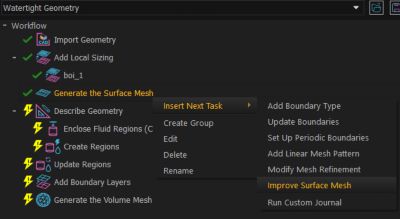
Ansys Fluent’s watertight geometry workflow accelerates the meshing process.
Best practices are embedded into each task for quality in the form of default values. However, advanced users can easily check a box to reveal more options. You can also automate the watertight geometry workflow meshing process using a Python-based journal file for batch meshing.
Using this workflow will ensure a high-quality mesh that generates robust results for most hydrogen gas turbine combustor cases.
2. Mosaic Poly-hexcore Meshing with Parallel Scalability
Fluent’s Mosaic meshing technology accelerates meshing time and produces a faster, more accurate solution. This technology enables polyhedral connections between disparate mesh types. Mosaic poly-hexcore is the first to employ this technology and is a combination of hexahedral, isotropic poly prism, and Mosaic polyhedral elements.
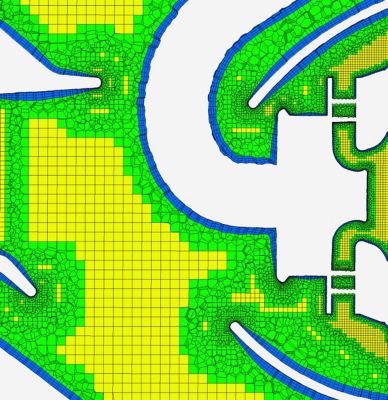
Mosaic poly-hexcore combines boundary layer mesh using high-quality polyhedron to hexahedron elements
Hexahedral elements are desired because of their accuracy and efficiency. Because the core volume mesh generates using hexahedral elements, meshing for the same grid resolution results in a total face count reduction. This delivers faster compute times with lower memory and disk space requirements.
Parallel meshing can accelerate the volume meshing process even more. It has the ability to generate over 10 million cells per minute when running on 256 cores.

Mosaic poly-hexcore mesh can generate over 10 million cells per minute when running on 256 cores
3. Inflation Layers
For hydrogen gas turbine combustion simulations, the large eddy simulation (LES) model is used in the core domain. Since LES is unable to accurately resolve the near-wall flow features, Fluent uses hybrid scale resolving simulation, such as stress-blended eddy simulation (SBES), with Reynolds-Averaged Navier-Stokes (RANS) near the walls.
With RANS applied near the walls, our third best practice suggests using three to four inflation layers.
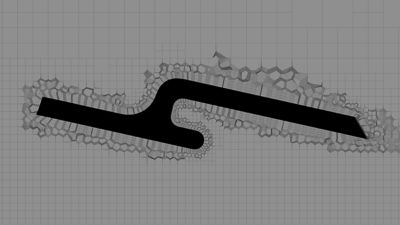
Three to four inflation layers will accurately capture the aero and thermal boundary
This number has proven to yield accurate results while avoiding cells collapsing into each other as they go through narrow passes and small orifices.
4. Mesh Resolution Per Part
A generic model of a hydrogen gas turbine combustor can be seen below.
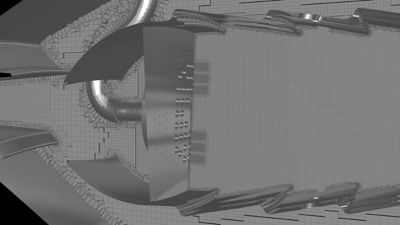
Generic hydrogen gas turbine combustor model
Because of the complex features in the combustor, it is recommended to use mesh resolution best practices for the following parts:
- Micromixer or swirler
- Use a body of influence (BOI) inside of the micromixer tube with a minimum of 20-25 cells across the diameter. We also recommend extending the BOI into the hot section with a length equivalent to 3-4 times the diameter of the tube.
- Combustor core
- Utilize BOI to generate a high-quality uniform mesh. This will ensure a smooth mesh transition from the dome into the core and accurately predict mixing, flame shape, and emissions.
- Dilution holes
- Have 8-10 cells across the diameter of the dilution hole to accurately predict quenching effects
- Dilution zone
- Resolution in the dilution zone can be coarser than in the primary zone. However, it is recommended to use a value that is twice the mesh size used in the BOI of the core
- Solid components
- If you are modeling the solid components, we recommend having 3-4 cells in a cross section
5. Target Mesh Quality
The quality of a mesh plays a significant role in the accuracy and stability of the numerical computation. Using the best practices listed above should result in a high-quality, simulation-ready mesh.
Cell orthogonal quality is computed using cell skewness, the vector from the cell centroid to each of its faces, the corresponding face area vector, and the vector from the cell centroid to the centroids of each of the adjacent cells. The value ranges between 0 to 1, with 1 representing perfect quality. Target an orthogonal quality that is higher than 0.1.
Aspect ratio equates to a measure of the stretching of a cell. It remains best to avoid sudden and large changes in the cell aspect ratio in areas where the flow field exhibits large changes or strong gradients. Target a low maximum aspect ratio when meshing your combustor.
For an in-depth explanation on each best practice, download the Ansys white paper 5 Best Practices for Hydrogen Gas Turbine Combustor Meshing Using Ansys Fluent.
Learn more about Ansys Meshing solutions here.